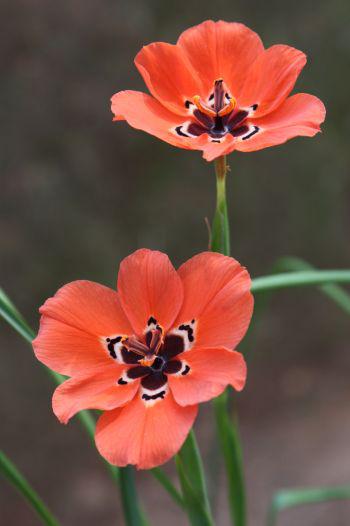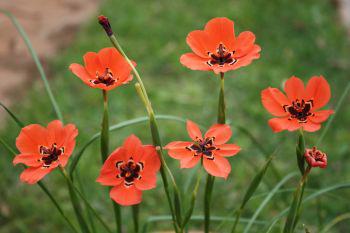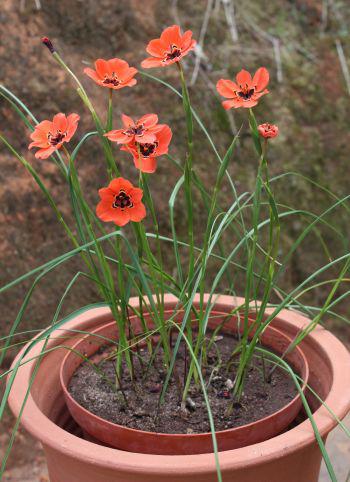Moraea insolens
Moraea insolens Goldblatt
Family: Iridaceae
Common names: Overberg red-moraea (Eng.); Overbergse rooi-uintjie (Afr.)
Introduction
Moraea insolens is a critically endangered, cormous plant, with dazzling orange-red or rarely white- or cream-coloured, salver-shaped blooms, with prominent, deep brown markings to attract its beetle pollinators. It is very rare in cultivation, but can be successfully grown as a container subject.

Description
Description
This deciduous, winter-growing geophyte grows 200–350 mm high and has a small, rounded corm, protected by a covering of hard, light brown outer tunics. The corm produces two, dark brown, basal sheaths and has a solitary, linear, bright green, channelled leaf. The slender flower stem has prominent nodes and is sometimes branched, producing a succession of salver-shaped flowers, each lasting three days, from between two spathe bracts. The tepals vary in shades of light to bright orange-red and are rarely white or cream-coloured.

The three outer tepals are larger than the three inner ones and all are adorned with a deep brown, arrow-shaped marking near the base, sometimes outlined in white. The filaments are united into a central column with three long anthers symmetrically arranged opposite the three outer tepals. The anthers produce sticky, bright orange pollen. The fruit is an elliptic capsule containing many small, light brown, irregularly shaped seeds. The plant flowers from mid- to late spring (mid-September to mid-October) and is completely dormant in summer. M. insolens is a very distinctive species in flower, not easily mistaken for any other member of the genus.

Conservation Status
Status
According to the Red List of South African Plants, consulted on 26 July 2016, Moraea insolens is assessed as Critically Endangered (CR). This is due mainly to massive habitat loss from expanding wheat fields and smothering overgrowth by alien plants. Furthermore, the plants fail to flower and set seed if the habitat is not burnt or cleared frequently enough. One subpopulation is protected within a private nature reserve near Stanford. Another to the east of Caledon, is surrounded by a fence in a state of disrepair and is threatened by alien vegetation, and another immediately west of this town, may be close to extinction, due to habitat disturbance. Wild-collected seeds of this species are in long-term cold storage in the Millenium Seed Bank at Wakehurst Place in the United Kingdom.
Distribution and habitat
Distribution description
Historically, Moraea insolens has always had a restricted distribution in the western part of the southern Cape and it is currently known from three, severely fragmented subpopulations, with much-depleted gene pools. Two of these are located below the Swartberg, near Caledon, the third to an area near the Klein Rivier Mountains, northeast of Stanford. The species is a narrow endemic of fertile, pebbly clay slopes in Western Rûens Shale Renosterveld, a vegetation type with exceptionally high levels of geophyte diversity. The plants occur as scattered individuals or in small clumps in open aspects, in soil which may become inundated for short periods, following heavy rain. In at least one site, it grows in association with the endangered, evergreen, blue- or lilac-flowered Aristea biflora. The species is suited to cultivation in containers in low humidity, frost-free environments.

Derivation of name and historical aspects
History
Philip Miller, the Scottish horticulturist and botanist, established the genus Morea in 1758, in tribute to the English horticulturist Robert More of Shropshire. Carolus Linnaeus later altered the spelling of the genus name to Moraea, in order to associate it with his father-in-law, the Swedish physician Dr Johan Moraeus. The specific name insolens, is descriptive of the radiant, glowing tepal colour of the orange-red forms. The species was first documented in the 1820s by the European botanical collectors, C.F. Ecklon and C.L. & Zeyher, who recorded it at two localities near Caledon. It was initially described as Homeria maculata by the German botanist F.W. Klatt in volume 34 of Linnaea in 1866. The plant appears not to have been recorded again until the early 20th century, when it was displayed at the Caledon Wild Flower Show in 1912 and 1931. A cream-coloured form was collected and painted in 1921 by Louise Guthrie at the Bolus Herbarium, from a locality just west of Caledon. Decades later, the English anthropologist and Iridaceae enthusiast Thomas T. Barnard, discovered a population of orange-red plants east of Caledon in 1968 and the species was described as Moraea insolens by Peter Goldblatt in volume 41 of The Flowering Plants of Africa in 1971, illustrated with a watercolour plate by Margo Branch. Occurring on a small piece of state-owned land, comprising just a few hectares, a protective perimeter fence was erected around this population and for many years, local volunteer conservationists have attempted to keep encroaching alien vegetation under control. In 2007, a small new population comprising some 50 individuals, was discovered within a private nature reserve to the northeast of Stanford. Plants from east of Caledon have been in continuous cultivation at Kirstenbosch, since 1982.
Comprising well over 200 species of winter-growing, summer-growing and evergreen cormous plants, Moraea is native to sub-Saharan Africa, the Mediterranean basin and the Middle East, and its centre of diversity is in the southwestern part of the Western Cape. The species vary from delicate, slender plants with exceptionally narrow, deciduous leaves, such as Moraea worcesterensis, to robust ones with leathery, relatively broad, evergreen leaves, like those of M. alticola and M. spathulata. The M. villosa (peacock moraea) from the Western Cape, is one of the most admired species. The most well-known member in ornamental horticulture is probably the frost-hardy, evergreen M. huttonii, a yellow-flowered, sweetly-scented species found from the Eastern Cape to Mpumalanga. Numerous species including M. aristata, M. gigandra, M. loubseri and M. tulbaghensis are threatened in the wild, due mainly to habitat loss. The corms of M. fugax (soetuintjie) can be eaten raw and are known to have been consumed by Cape hunter-gatherer peoples. The genus also contains several, very poisonous, weedy species, such as M. miniata (pronktulp) and M. polystachya (bloutulp), which are problematic to stock farmers in South Africa and have become invasive in parts of Australia. Due to their deciduous nature and requirement of a dry, dormant period in most species, the deciduous moraeas are generally unsuited to general garden cultivation and best grown in containers.
Ecology
Ecology
Moraea insolens is deciduous and winter-growing, adapted to cool, moist winters and hot, dry summers. Vegetative growth commences in late autumn with the onset of rain. Flowering takes place in late spring towards the end of the growing season, and the corms are completely dormant in summer. During the course of each growing season a new corm develops directly above the old one, the latter withering completely by early summer. The corms become securely wedged between shale pebbles in heavy clay, which bakes hard in summer, an adaptive strategy to obstruct excavation by Cape porcupines. The salver-shaped flowers are pollinated by at least three species of hairy monkey beetle, which consume its pollen, attracted by the brightly coloured, orange-red tepals and prominent deep brown, arrow-shaped beetle markings near the base of each tepal. In the wild, flowering in this species is strongly stimulated by regular summer fires, which clear smothering overgrowth, failing which the corms only produce leaves or remain dormant. Following a fire, the plants are vigorous and flower prolifically in the first spring season, but by the third successive spring, no flowers are produced. When ripe, the dry seed capsule splits open spontaneously along three longitudinal lines, and the seeds are dispersed in early summer by the shaking action of wind.
Uses
Use
This species has no traditional, economic or magical uses.

Growing Moraea insolens
Grow
Moraea insolens is a delicate species. It is not too difficult to grow in containers, but is wholly unsuited to general cultivation in garden beds and rockeries that are irrigated in summer, as it requires a dry, summer-dormant period, and its corms would certainly be taken by molerats and porcupines. Plastic pots 25–30 cm in diameter, are recommended, placed in a position receiving full morning sun and afternoon shade. It requires protection from heavy winter rain, such as is experienced in the southern suburbs of Cape Town; is frost-sensitive, and must have a completely dry summer dormant period. Although it occurs naturally in stony clay soils in the wild, it readily adapts to well-drained, acid, sandy media in cultivation. A suggested mixture is equal parts of coarse silica sand and finely sifted compost, with the addition of a 5 cm layer of compost placed in the base of the pot. Plant the corms in late autumn, about 3 cm deep, and give an initial heavy watering. Once the leaf shoots appear, water heavily about twice per week throughout the winter months. This species flowers at the end of the growing season and it is important for the plants to be well-watered throughout spring, in order for the developing flower spikes to remain strong and not abort. Once the leaves begin to turn brown in late spring, withhold watering altogether for the duration of summer. Mature corms tend to become moribund when cultivated over periods of many years, however, lifting the corms and replanting them into new soil every 3–5 years, certainly assists in moderating this tendency.
The corms do not readily produce offsets, and in order to maintain this species in cultivation, it is essential to continually propagate it from seed. Hand-pollination and isolation from other species of Moraea is essential to obtain pure seeds that will flower true-to-type. Sow the seeds in autumn in the same medium recommended for adult corms. If sown fresh, seeds will germinate within 4 weeks and in ideal conditions, seedlings can be expected to flower in the third or fourth year.
The developing flower buds are susceptible to infestation by aphids, and the leaf lower surfaces may become infested with red spider mites when grown in enclosed, poorly ventilated conditions. The corms are not usually susceptible to attack by mealy bug, but fungal rotting will take place if not kept dry in summer.
References
- Duncan, G.D. 1997. Moraeas of the Western Cape. Veld & Flora 83(2): 42–44.
- Duncan, G.D. 2002. Just holding on: spectacular geophytes in peril. Veld & Flora 88(4): 142–147.
- Duncan, G.D. 2010. Grow bulbs. Kirstenbosch Gardening Series. South African National Biodiversity Institute, Cape Town.
- Duncan, G.D. 2015. Moraea insolens. Veld & Flora 101(1): 19.
- Goldblatt, P. 1971. Moraea insolens. The Flowering Plants of Africa 41: t. 1639.
- Goldblatt, P. 1989. The moraeas of southern Africa. Annals of Kirstenbosch Botanic Gardens vol. 14. National Botanic Gardens, Cape Town.
- Goldblatt, P., Bernhardt, P. & Manning, J. 2005. Pollination mechanisms in the African genus Moraea (Iridaceae, Iridoideae): floral divergence and adaptation for pollinators. Adansonia (series 3) 27: 21–46.
- Mucina, L. & Rutherford, M.C. 2006. The vegetation of South Africa, Lesotho and Swaziland. Strelitzia 19. South African National Biodiversity Institute, Pretoria.
Credits
Graham Duncan
Kirstenbosch National Botanical Garden
November 2016
Plant Attributes:
Plant Type: Bulb
SA Distribution: Western Cape
Soil type: Sandy, Clay
Flowering season: Spring
PH: Acid
Flower colour: Red, White, Cream, Orange
Aspect: Morning Sun (Semi Shade)
Gardening skill: Average
Special Features:
Horticultural zones







Rate this article
Article well written and informative
Rate this plant
Is this an interesting plant?
Login to add your Comment
Back to topNot registered yet? Click here to register.